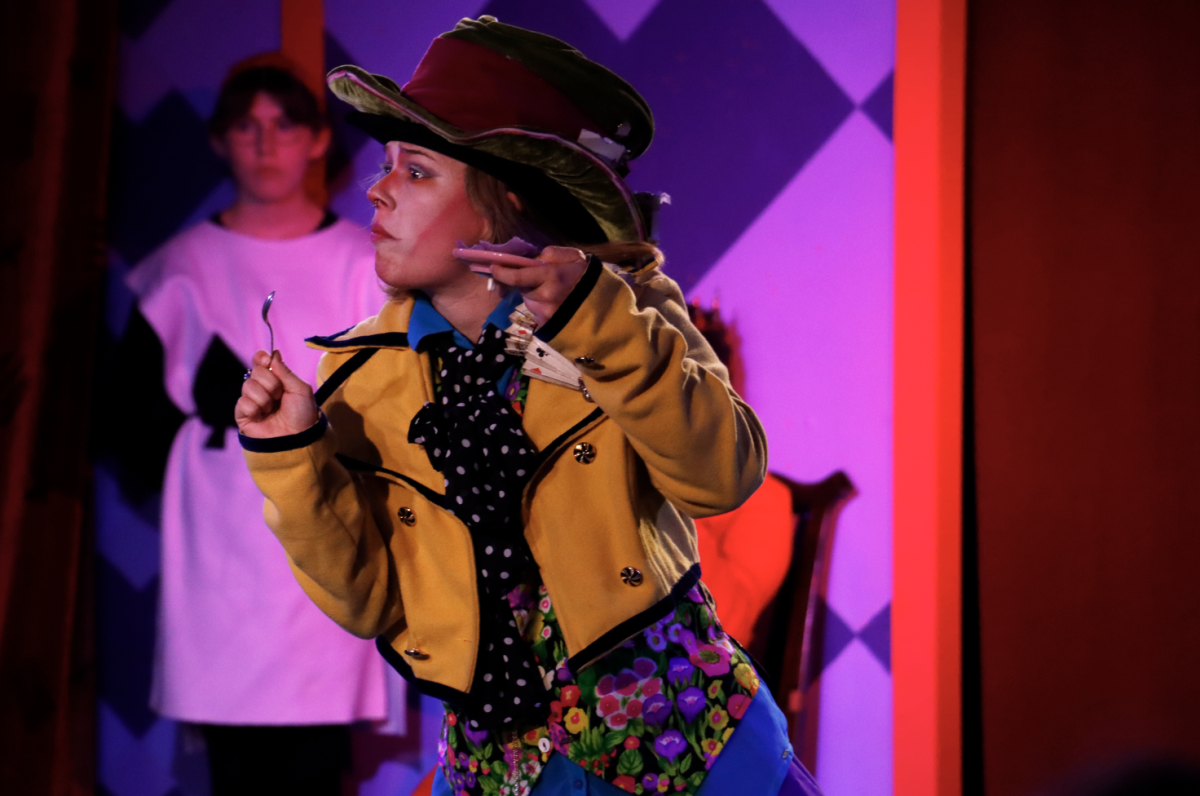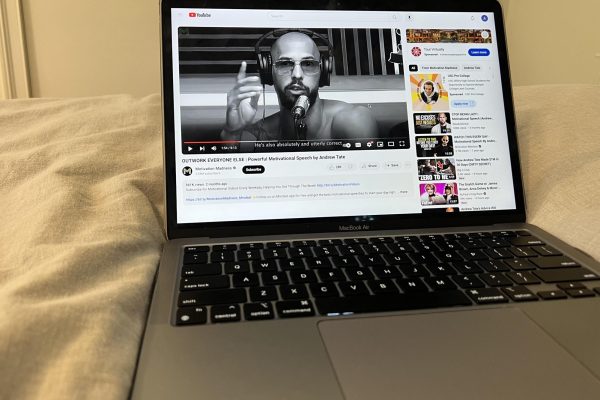Column: Why I’m not the ideal Latina
Photo credit: Rosemarie Becerra-Ayala
The image features my grandmother’s 80 birthday dinner with two of my cousins, my sister and myself surrounding her. My grandmother’s skin tone was far lighter than either of my two cousins and more similar to me and my sister’s.
November 15, 2020
It’s my abuela’s 80 birthday. All four grandchildren surround her. My younger cousin stares at the heavily decorated chocolate cake while my older cousin, sister and myself stare up at my grandmother. Back then I must have been eight or nine years old. Back then I didn’t notice the stark differences between my cousins and extended family compared to myself or my immediate family. Scientifically speaking, at that age I should have already unconsciously started to form my own judgements about skin pigmentation and how different me and my sister’s skin looked compared to that of our cousins. Or, my cousins should have noticed how different they looked to my grandmother. Either way, I didn’t realize how much this tiny difference could dictate how we were treated in the given standard of the Latino community.
The first piece of the female latino body culture puzzle is skin. Skin plays a huge role in most minority cultures and tanning has become a money-making phenomenon in the United States. In 2012, Dionne P. Stevens, an assistant professor in the Department of Psychology at Florida International University, and Paula Fernández as assistant professor in the Department of Sociology at William Paterson University published an experiment they did in the Hispanic Journal of Behavioral Sciences. Their thesis, The Role of Skin Color on Hispanic Women’s Perceptions of Attractiveness, includes many responses from women who express their thoughts on skin color. Out of 34 women used in the experiment 31 of them reported “that the ideal skin color of a Hispanic woman was tan.” This was seen as the midrange point between pale skin and darker skin. This was particularly important for determining their acceptance in and perceptions that they were part of the Hispanic community. Having “some color” was viewed as an important symbol of their “authentic Hispanic identity.”
Skin is important in any culture. The Latinx community has such a broad range of nationalities and geographically spans across two continents, so it seems obvious that there would be many people who vary in skin pigmentation. But, like most minority cultures, there is always a bar to reach and is set in place for people to look like. The results of the experiment listed a “tan” skin color as preferred; pale skin was viewed as “plain” and unattractive”.
In my opinion the goal of tanning is to get dark, but not too dark. To stay somewhat light, but not too light. I don’t have “tan” skin. I burn easily. I can’t tan even if I tried to. My pale skin sets me apart from my community, and many people don’t even register me as Latina when I first meet them because of it. Not too long ago, when I was a shy sixth grader at Archer, one of the seventh graders had invited me to go to the Hermanas Unidas affinity space. I remember being somewhat terrified at being vulnerable in front of the other students, many of whom I hadn’t met before. Right at the door one of the girls had said very nicely that she appreciated support from allies but that this meeting “was only for students who identified as Latinx” or some variation of that. Since I had gone alone, I didn’t have anybody to claim my place in that meeting or to help me get the word across that yes, I have light skin but I’m still Latina and part of the Hermanas Unidas group. Too scared to stand up to an upper schooler, I silently excused myself and didn’t return to join Hermanas until eighth grade.
The next piece of the puzzle is the “hourglass” body type that leaks and embeds itself into every female mindset at least once in one’s life. Besides the harming effects of impossible beauty standards in mainstream media (a discussion for another day), I’ve noticed that the Latina stereotype (thick Spanish accent and curvaceous figure) flood the film and TV industry. Sofia Vergara, a Colombian actress, is best known for her role as Gloria Pritchett on Modern Family. On the show she completely enforces the most stereotypical role a Latina can play. Gloria is the loud and “spicy sexy latin” foreigner who has married rich and moved to America for a “better life”. Although there is some truth in stereotypes, the show focuses on her “hourglass figure” and implies to people watching that a Latina should look that way. Jennifer Lopez, a role model of mine and incredible icon in the Latinx community, also enforces the stereotypical way a Latina should look. This won’t stop me from loving her any less, but she does paint the picture that a Latina should always look the way she does. Both Vergara and Lopez have the tan skin and curvy figure that repeatedly is shown across mainstream media which illustrate the way a Latina “should” look. I on the other hand do not look like JLo (we can wish though). I’m shorter than most of my friends and have the flattest chest on the planet and like I said before– I have white skin.
You may be thinking that this problem is not unique to Latin culture. And while people in other communities may want to look a certain way, I feel that in Latin culture these stereotypes are things Latinas must or are supposed to have. In the community, there is an almost tangible want to look a certain way as opposed to the need to.
I’m not eight anymore. I see the way I’m treated compared to my cousins by other family members or even complete strangers. Some don’t even believe we are related. I may speak Spanish, listen to reggaeton and eat tamales on Christmas, but my light skin and flat chest set me far apart from the “ideal” Latina.




![Freshman Milan Earl and sophomore Lucy Kaplan sit with their grandparents at Archer’s annual Grandparents and Special Friends Day Friday, March 15. The event took place over three 75-minute sessions. “[I hope my grandparents] gain an understanding about what I do, Kaplan said, because I know they ask a lot of questions and can sort of see what I do in school and what the experience is like to be here.](https://archeroracle.org/wp-content/uploads/2024/03/grandparents-day-option-2-1200x800.jpg)































































Allie Yang • Nov 25, 2020 at 8:04 am
This was such an amazing op-ed! I loved how you tied body culture/image to your Latina identity.
Viv • Nov 19, 2020 at 11:00 am
I was also very scared to go to an affinity space recently for this very reason. Your article is fantastic, and perfectly highlights issues that need to be seen more often.
Bess • Nov 18, 2020 at 12:20 pm
This is an amazing op ed! so well written. Truly one of my favorite pieces I’ve read on the oracle, ever. Great combination of personal experience and societal trends.
Lizette Gonzalez • Nov 18, 2020 at 9:42 am
Ale, wow. I really enjoyed reading this and I definitely found myself agreeing and reflecting on topics you mentioned, thank you.
J Feuerborn • Nov 17, 2020 at 2:25 pm
Hi Alejandra, I really liked your Op-Ed. As a fellow Latina who teaches in a predominately Latino school, I cannot tell you the amount of times, I’ve had to “prove” myself as a Latina. Saying I’m Chilean is not good enough. Having an American first name given by my mother and taking my husband’s Dutch last name doesn’t help either. Yup, with 20 Spanish speaking countries, we do look different. That’s what makes us so unique. Keep being you and yeah, I do wish to one day wake up and look like JLo too but that’s not happening anytime soon. Stay safe and keep writing good journalism.
-J